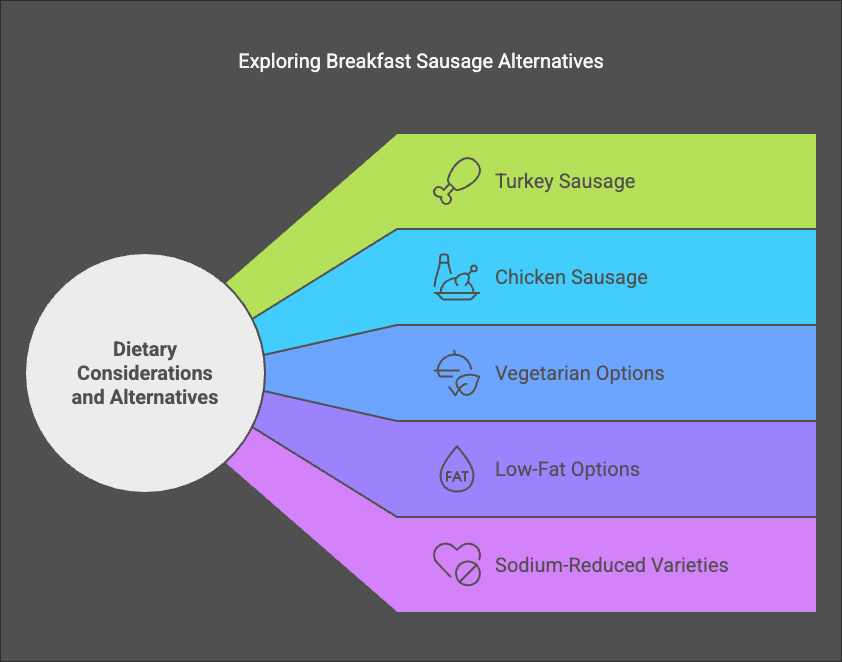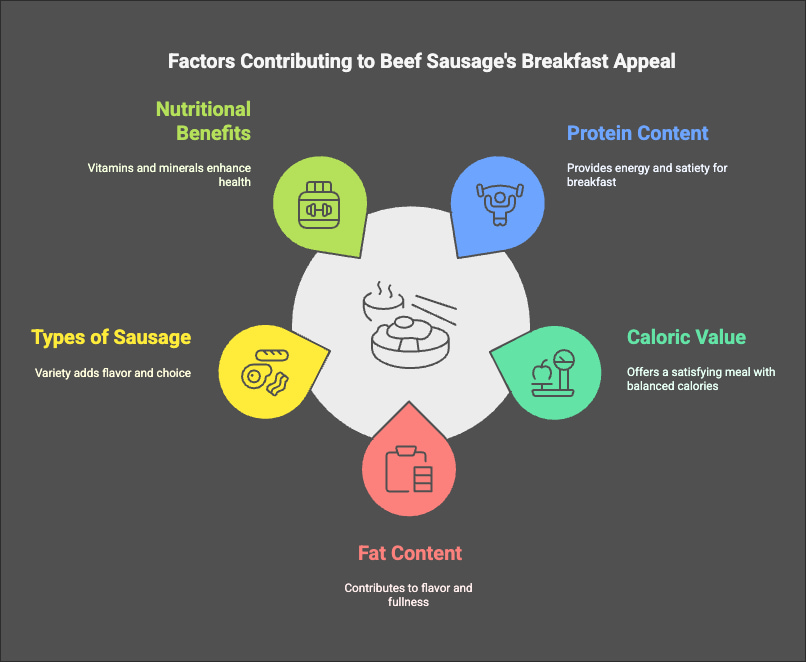Beef sausage is a favorite for breakfast. Knowing its nutritional value is key to good eating habits. It’s a good breakfast choice, but it’s important to know its pros and cons.
Understanding beef sausage’s nutritional aspects is crucial for a healthy breakfast. Knowing its benefits and drawbacks helps make better breakfast choices. Pairing beef sausage with other foods can enhance its nutritional value.
Key Takeaways
- Beef sausage is a common breakfast food with potential health benefits
- Understanding the nutritional profile of beef sausage is essential for informed dietary choices
- Beef sausage can provide protein and energy for breakfast
- Breakfast nutrition should consider the overall nutritional profile of beef sausage
- Pairing beef sausage with other breakfast foods can maximize its health benefits
- Beef sausage health benefits and drawbacks should be considered for a balanced breakfast
Understanding Beef Sausage as a Breakfast Protein
Beef sausage is a key part of many breakfasts. It’s packed with protein to start your day off right. It gives you the energy you need to tackle the morning.
Beef sausage is made from various meats, seasonings, and spices. Each type has its own flavor and texture. You can find classic pork and beef, spicy Italian, and chorizo sausages.
- Classic pork and beef sausage
- Spicy Italian sausage
- Chorizo sausage
Adding beef sausage to your breakfast can boost your energy and keep you going all morning. Whether you like something classic or spicy, there’s a sausage for everyone.
Beef sausage is also good for you. It’s full of protein, vitamins, and minerals. Just make sure to pick a high-quality sausage with no bad additives. Eating beef sausage for breakfast can make your meal delicious and keep you full until lunch.
| Type of Sausage | Protein Content | Calories per Serving |
|---|---|---|
| Classic Pork and Beef Sausage | 20-25 grams | 250-300 calories |
| Spicy Italian Sausage | 25-30 grams | 300-350 calories |
| Chorizo Sausage | 20-25 grams | 250-300 calories |
Nutritional Profile of Beef Sausage
Beef sausage is a popular breakfast choice. It’s important to know its nutrition facts. A serving has about 200-300 calories, with lots of protein and fat.
The protein content is 10-20 grams per serving, making it a great option for a filling breakfast.
Beef sausage has a lot of fat, up to 20-30 grams per serving. But not all fats are bad. Some are good in small amounts. Also, the sodium in some sausages can be high.
Here are some key nutrition facts to consider when evaluating beef sausage as a breakfast option:
- Calories: 200-300 per serving
- Protein: 10-20 grams per serving
- Fat: 10-30 grams per serving
- Sodium: varies by product but can be relatively high
Knowing the nutrition facts and dietary considerations helps you decide if beef sausage is right for breakfast.
Protein Content and Morning Energy Levels
Protein is key for a good breakfast. It helps keep you full and gives you energy in the morning. Foods high in protein, like eggs or Greek yogurt, are great for breakfast.
Protein Requirements for Breakfast
How much protein you need varies. But aim for 20-30 grams at each meal. Eggs, Greek yogurt, or beef sausage can help meet this goal.
How Beef Sausage Affects Satiety
Beef sausage is a protein-rich food. It can make you feel full longer, so you don’t need snacks later. Here are some breakfast ideas with beef sausage:
- Beef sausage with scrambled eggs and whole-grain toast
- Beef sausage and vegetable omelet
- Beef sausage and avocado wrap
Impact on Morning Metabolism
Beef sausage in your breakfast can boost your metabolism. The protein in it helps burn calories all day.
| Breakfast Meal Idea | Protein Content | Calories |
|---|---|---|
| Beef sausage with scrambled eggs and whole-grain toast | 30 grams | 350 calories |
| Beef sausage and vegetable omelette | 25 grams | 250 calories |
| Beef sausage and avocado wrap | 20 grams | 300 calories |
Fat Content and Health Considerations
The fat content of beef sausage is key to a balanced diet. A typical serving has a lot of fat, which can affect health. Therefore, it’s important to consider dietary considerations when eating beef sausage often.
Some important things to remember about beef sausage’s fat include:
- High fat content can increase calorie intake
- Saturated fat in beef sausage may raise cholesterol levels
- Regular consumption can lead to weight gain and other health issues
To make smart choices, it’s crucial to look at beef sausage’s fat content in a balanced diet. Knowing the health risks helps people enjoy beef sausage while staying healthy.
Being aware of beef sausage’s fat content and dietary considerations helps make better choices. This way, people can maintain a healthy and balanced diet.
| Fat Content | Health Implications |
|---|---|
| High-fat content | Increased calorie intake, weight gain |
| Saturated fat | Raised cholesterol levels, heart health issues |
 Is Beef Sausage Good for Breakfast? The Expert Verdict
Is Beef Sausage Good for Breakfast? The Expert Verdict
Beef sausage can be a good choice for breakfast. It gives you protein and energy to start your day. But it’s important to know both the good and bad sides before deciding.
Benefits of Morning Consumption
Beef sausage can add nutrition to your breakfast. It offers several benefits, including:
- High-quality protein to support muscle growth and satisfaction
- Essential vitamins and minerals, such as vitamin B12 and iron
- A boost to morning energy levels and metabolism
Potential Drawbacks to Consider
Even though beef sausage is healthy, there are some downsides to think about, such as:
- High sodium content
- Presence of saturated fats and cholesterol
- Potential allergens and intolerances
Recommended Portion Sizes
To get the most from beef sausage while avoiding its downsides, eat it in moderation. Aim for 2-3 slices. Pair it with whole grains, fruits, and veggies for a balanced breakfast.
Comparing Beef Sausage to Other Breakfast Meats
Looking for a protein-rich breakfast? There are many options. Beef sausage is a favorite, but how does it stack up against others? A healthy breakfast is key to a great start. Knowing the nutritional values of different meats helps us make better choices.
Beef sausage has a unique nutritional profile compared to bacon, ham, and turkey sausage. Here are some main differences:
- Beef sausage generally has a higher protein content than bacon and ham
- Turkey sausage often has lower fat levels than beef sausage
- Ham tends to be higher in sodium than other breakfast meats
For a healthy breakfast, consider pairing beef sausage with other nutrient-dense foods. This balances out the meal. A protein-rich breakfast keeps you full until lunch, making it a must for daily routines.

The choice of breakfast meat depends on personal taste and dietary needs. By knowing the nutritional profiles of different meats, we can choose a healthy breakfast that fits our needs.
Best Cooking Methods for Breakfast Beef Sausage
There are many ways to cook beef sausage for breakfast. You can choose between pan-frying, grilling, or oven-baking. Each method gives a different taste and texture. Let’s look at the best ways to cook breakfast beef sausage.
Pan-Frying Techniques
Pan-frying makes beef sausage crispy on the outside and juicy inside. To do this, heat a skillet over medium-high. Add a bit of oil and cook the sausage for 5-7 minutes on each side. This way, it will be browned and fully cooked.
Grilling Options
Grilling adds a smoky flavor and a nice char to beef sausage. To grill, preheat your grill to medium-high. Place the sausage on the grill and cook for 5-7 minutes on each side. It will be browned and cooked through.
Oven-Baking Methods
Oven-baking is easy and requires little effort. Preheat your oven to 400°F (200°C). Place the sausage on a baking sheet and bake for 15-20 minutes. It will be fully cooked.
Beef sausage is great with eggs, toast, and hash browns. Or, try it in a tortilla with cheese and salsa. There’s a recipe for every taste.
- Use a thermometer to ensure the sausage is cooked to a safe internal temperature.
- Don’t press down on the sausage with your spatula, as this can squeeze out juices and make the sausage dry.
- Let the sausage rest for a few minutes before serving, as this allows the juices to redistribute and the sausage to stay moist.
Healthy Pairing Suggestions for a Complete Breakfast
Pair beef sausage with healthy foods for a complete breakfast. A balanced diet needs fruits, vegetables, whole grains, and lean proteins. Here are some good pairing ideas for beef sausage.
Some healthy pairing options include:
- Fresh fruits, such as berries or citrus
- Roasted vegetables, like bell peppers or sweet potatoes
- Whole grain toast or English muffins
- Low-fat dairy products, such as milk or yogurt
These options help make a balanced diet with beef sausage. Adding different foods to your breakfast ensures you get all the nutrients you need. Choose whole, unprocessed foods for the best nutrition. you can also check out our post of Breakfast Fruit Salad: Simple Ways to Enjoy Fresh Fruits
Don’t forget about your drinks with breakfast. Green tea or freshly squeezed juice adds antioxidants and supports a balanced diet. Simple changes to your breakfast can make it healthier and keep you energized all morning.
| Food | Nutritional Benefits |
|---|---|
| Beef Sausage | High-quality protein, iron, and zinc |
| Fresh Fruits | Vitamins, minerals, and antioxidants |
| Whole Grains | Fiber, vitamins, and minerals |
Tips for Choosing Quality Breakfast Beef Sausage
It is important to choose the right breakfast beef sausage. Look at the nutrition facts and dietary considerations. A good sausage should have wholesome ingredients and a balanced nutritional profile.
To pick the best sausage, read the labels carefully and understand the ingredients. Opt for products with few added preservatives and artificial flavorings. Also, consider the sodium content and fat percentage to meet your dietary needs.
Reading Labels Effectively
- Check the ingredient list for whole foods and minimal processing
- Look for certifications like “low-sodium” or “organic” if relevant to your dietary considerations
- Be aware of serving sizes and nutrition facts to make informed decisions
Identifying Quality Indicators
Quality indicators help find a top-notch beef sausage. Look at the meat type and added nutrients. Here are some key factors to consider:
| Factor | Description |
|---|---|
| Meat Quality | Look for sausages made with high-quality meats, such as grass-fed beef |
| Added Nutrients | Consider sausages with added nutrients, such as vitamins or minerals |
| Minimal Processing | Choose sausages with minimal added preservatives and artificial flavorings |
You can choose a quality breakfast beef sausage by looking at these factors and understanding nutrition facts.
Making Beef Sausage Part of a Balanced Diet
To add beef sausage to a balanced diet, think about the nutrients in your meals. A healthy breakfast gives you energy and keeps you full. Beef sausage can be a good choice for healthy breakfast options when you pair it with other foods that are good for you.
Here are some ways to make beef sausage a part of a balanced diet:
- Pairing beef sausage with whole grains, such as whole-wheat toast or oatmeal
- Adding fruits or vegetables to your breakfast plate
- Choosing leaner beef sausage options or reducing the serving size
By adding beef sausage to your healthy breakfast options and balancing it with other healthy foods, you can have a fulfilling and balanced diet. Always pick high-quality ingredients and watch your portion sizes to stay healthy and balanced.
| Food | Calories | Protein | Fat |
|---|---|---|---|
| Beef Sausage | 250 | 20g | 18g |
| Whole Wheat Toast | 89 | 4g | 1g |
| Fresh Fruit | 50 | 1g | 0g |
Special Dietary Considerations and Alternatives
Traditional beef sausage might not be the best choice for those with specific dietary needs. This is where dietary considerations and alternative protein sources come in. They offer nutritious and satisfying breakfast options, even with health restrictions or personal preferences.
Turkey sausage, chicken sausage, and vegetarian options like tofu or tempeh are popular alternatives. They are as tasty as traditional beef sausage but fit specific dietary considerations. Many brands also offer alternative protein sources that are low in fat and sodium, perfect for a healthier breakfast.
Low-Fat Options
Looking to cut down on fat? Leaner meats like turkey or chicken and vegetarian options like beans or lentils are good choices. Some brands even offer reduced-fat beef sausage, a tasty compromise for those who still want beef but with fewer calories.
Sodium-Reduced Varieties
For those with high blood pressure or heart health concerns, sodium-reduced beef sausage is a good option. These products have less sodium than traditional sausage, making them healthier. Brands also offer low-sodium alternatives with alternative protein sources like turkey or chicken.
Alternative Protein Sources
Beyond traditional beef sausage, many alternative protein sources offer a nutritious and delicious breakfast. Some favorites include:
- Turkey sausage
- Chicken sausage
- Vegetarian options like tofu or tempeh
- Beans or lentils
These alternatives are as tasty and satisfying as traditional sausage while meeting specific dietary considerations.

By considering dietary considerations and exploring alternative protein sources, individuals can enjoy a nutritious and delicious breakfast that meets their unique needs and preferences.
| Alternative Protein Source | Calories per Serving | Fat Content | Sodium Content |
|---|---|---|---|
| Turkey Sausage | 200-250 | 10-15g | 400-500mg |
| Chicken Sausage | 180-220 | 8-12g | 350-450mg |
| Vegetarian Option (Tofu) | 150-200 | 5-10g | 200-300mg |
Conclusion: Making an Informed Choice About Breakfast Beef Sausage
Beef sausage can be a great choice for breakfast. It’s full of protein, which helps with morning energy and feeling full. But it’s important to watch out for fat and sodium. Choose options that are high-quality and not too processed.
Adding beef sausage to your breakfast can make it more satisfying and energizing. Knowing its health benefits and downsides helps you decide if it’s right for you. A balanced breakfast with many nutrient-rich foods is best for a day full of energy and productivity.
FAQ
What defines breakfast sausage?
Breakfast sausage is a type of sausage eaten at breakfast. It’s usually made from pork or beef. It also has spices and seasonings.
What are the common types of beef sausage?
Beef sausage comes in links, patties, and ground forms. Each type has its own size, shape, and taste.
How does beef sausage contribute to a protein-rich breakfast?
Beef sausage is full of protein. This gives you energy in the morning and keeps you full all day.
How does the protein in beef sausage affect morning energy levels?
The protein in beef sausage helps keep your energy up. It makes you feel full and supports your body’s functions.
What are the benefits and drawbacks of consuming beef sausage for breakfast?
Beef sausage is good for breakfast because it’s full of protein. But it also contains a lot of fat and sodium. It’s important to eat it in moderation.
What are the best cooking methods for preparing beef sausage for breakfast?
The best ways to cook beef sausage are pan-frying, grilling, and baking. These methods help keep the flavor and texture good while reducing fat.
What are some healthy pairing suggestions for a complete breakfast with beef sausage?
Pair beef sausage with fruits, veggies, whole grains, and low-fat dairy. This makes a balanced and nutritious breakfast.


 Is Beef Sausage Good for Breakfast? The Expert Verdict
Is Beef Sausage Good for Breakfast? The Expert Verdict

